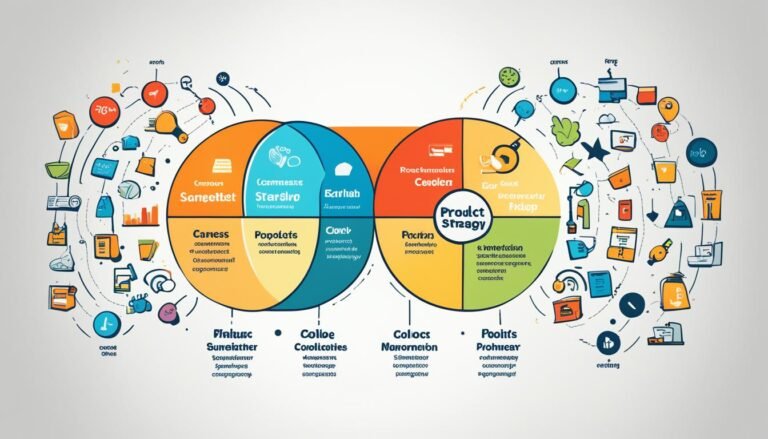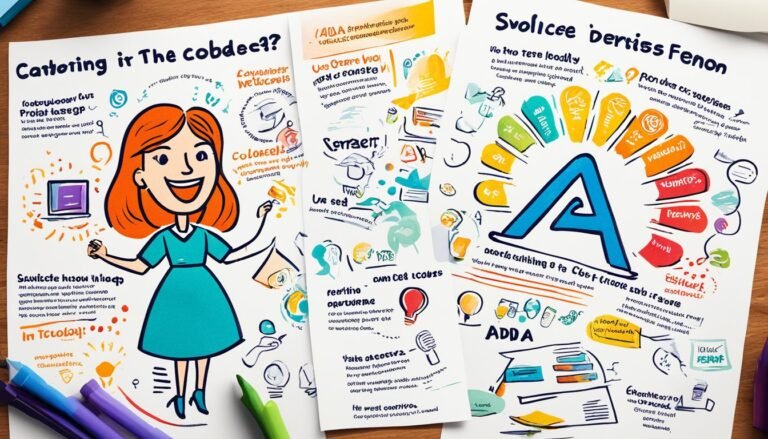AIDA Model: From Attention to Action
In 2018, American Express teamed up with influencers for their “Shop Small” campaign. This move drew a lot of interest. It shows how well the AIDA Model works in marketing and getting people to make choices.
The AIDA Model is key in marketing. It helps guide people from noticing something to buying it. Even with new tech and many ways to market, the AIDA Model still helps make marketing work well.
Key Takeaways
- The AIDA Model consists of four key stages: Attention, Interest, Desire, and Action.
- Effective marketing captures attention using bold visuals and headlines, as seen in campaigns by J.P. Morgan Chase and Charles Schwab.
- Generating interest might involve influencers, personal testimonials, or campaigns like American Express’ “Shop Small”.
- Creating desire often leverages emotional storytelling, demonstrated by MassMutual’s “Live Mutual” campaign.
- Action is driven through clear calls-to-action and promotional tactics, exemplified by companies like SoFi and Ally Bank.
Introduction to the AIDA Model
The AIDA model is key for those in marketing or sales. It guides businesses through the sales funnel, affecting buyer behavior at every step.
Defining the AIDA Model
The AIDA model stands for Attention, Interest, Desire, and Action. It’s a framework in marketing psychology. It shows four main stages that lead a consumer from awareness to buying.
In the Attention phase, ads work to grab the audience’s attention in a crowded digital world. Next, Interest keeps the audience hooked and curious about what’s being offered. The Desire phase makes people want the product, using emotions and needs. Finally, the Action phase gets people to buy, with clear calls to action.
Importance in Modern Marketing
The AIDA model is crucial for today’s marketing. It helps brands understand what drives buyers, making messages more impactful. This method fits well with the sales funnel, from creating catchy landing pages to designing strong call-to-actions.
Using the AIDA model, marketers can guide potential customers smoothly through their journey. Each step makes marketers think about how their messages connect with consumers. This ensures every interaction moves people closer to becoming loyal customers.
History of the AIDA Model
The AIDA model has a rich history in marketing, starting with Elias St. Elmo Lewis in 1898. This was the early days of modern advertising. Lewis’s model set the stage for many marketing models that came later.
Origin and Evolution
Elias St. Elmo Lewis, a marketing pioneer, created the AIDA model. He was later inducted into the Advertising Hall of Fame. The model introduced four key stages: Attention, Interest, Desire, and Action.
Over time, the AIDA model changed to fit new marketing ways, like print, radio, TV, and digital. It has stayed relevant across these changes.
Models like AIDA have shown they can adapt to new market trends. Lewis’s work showed how important it is to grab attention and guide people to make a purchase.
Significant Milestones
The AIDA model has seen many important moments in marketing history. By the late 19th and early 20th centuries, many companies used it. It helped businesses craft messages that moved people from awareness to buying.
In the mid-20th century, the AIDA model became part of marketing education. A 2022 study showed it’s still useful today, especially with AI and machine learning in retail.
Now, the AIDA model is a top marketing framework, updated for social media and other new channels. It helps companies plan their messages to reach people at different stages of buying. This way, companies can keep up with market changes.
What Does AIDA Stand For?
The AIDA model is a key tool in marketing. It helps guide people from seeing something to buying it. AIDA means Attention, Interest, Desire, and Action. It has helped turn customers into loyal ones since the late 1800s.
Attention: Grabbing the Audience’s Eye
Getting attention is the first step in the AIDA model. It’s about making content that grabs people’s attention. If you catch 80% of your audience’s attention, you’re off to a great start.
Good ways to get attention include bold visuals, catchy headlines, and impactful images. These draw people in and make them want to learn more.
Interest: Keeping Them Engaged
After grabbing attention, you need to keep people interested. This means sharing content that’s engaging and relevant. Things like informative articles, videos, or social media posts can really help.
It’s important to make sure the content matches what your audience likes and needs. This keeps them curious and interested.
Desire: Creating a Need
Desire is about building an emotional connection. You need to show how your product or service adds value. Sharing testimonials and benefits can make people really want what you’re offering.
This step is key to turning people from just being interested to actually wanting to take action.
Action: Driving Conversions
The last step is action, where you encourage people to do something. This could be buying something, signing up for a newsletter, or trying a free trial. The call-to-action should be clear and strong.
How well the AIDA model works can depend on the audience and the way you communicate with them. But when done right, it can really boost sales.
How to Apply the AIDA Model to Your Marketing Strategy
Using the AIDA model can change your marketing from just getting attention to getting people to act. It helps increase customer engagement and boost conversion rates. Let’s look at each step and see how to use persuasive messaging for a successful marketing strategy.
Attracting Attention
This first step is about catching the audience’s eye. Use bold headlines, eye-catching visuals, and interesting content. Companies have just a few seconds to make a strong first impression. Adding captivating images and personalized touches can really help.
Generating Interest
After grabbing attention, keep it by meeting your audience’s needs. Create content that’s relevant and engaging to their interests. Show off what makes your product or service special and how it benefits them.
Sparking Desire
To go from interest to desire, build emotional connections. Show how your product or service goes beyond what they expect. Use testimonials, success stories, and special offers to make them want what you’re offering. Highlighting how it can change their lives can be a strong motivator.
Encouraging Action
Finally, make it easy to take action. Clear and strong calls to action (CTAs) are key. Free trials, pop-up offers, and engaging prompts can push people to act. The success of your messaging is seen in how easily and quickly people move from attention to action.
Real-World Examples of the AIDA Model in Action
The AIDA model helps guide people from just looking to making a purchase. Let’s look at how it works in real marketing.
Hyundai’s “Smaht Pahk” Ad
Hyundai’s “Smaht Pahk” ad was a hit during the Super Bowl. It grabbed attention with humor and Boston accents from stars like Chris Evans and John Krasinski. People laughed and got interested because it was relatable and smart.
Then, it showed off Hyundai’s smart parking feature. This made people want it because it was useful and convenient. The ad ended by telling viewers to visit the Hyundai website or dealership, moving them from attention to action.
Other Notable Campaigns
Other companies have also used the AIDA model well. Apple, for example, has made their product launches exciting. They catch your eye with stunning visuals, keep you interested with details, and push you to act with special pre-orders.
Netflix uses the AIDA model too. It offers a free trial to grab your attention and keep you interested with lots of content. It makes you want more by showing exclusive shows and movies, leading you to subscribe.
CRED and Adidas have also used the AIDA model. CRED got a lot of people talking with famous ’90s stars. Adidas teamed up with top athletes to create desire and get people excited about new products.
These examples show how important the AIDA model is for marketing. It helps companies move people from just looking to actually buying, improving decision-making and sales.
AIDA Model: From Attention to Action
The AIDA Model is key in digital marketing. It helps guide consumers from getting their attention to taking action. This part will cover how to use the AIDA Model and share success stories to show its impact.
Practical Steps to Implement the Model
Using the AIDA Model means following steps to catch attention, keep interest, create desire, and encourage action. Here’s how to do it well:
- Attention: Start with a catchy headline or visual that grabs the consumer’s eye. Since people’s attention spans are short, your first impression must be strong.
- Interest: Keep interest by sharing useful content and stories. Showing how you solve problems can make your content more relatable and keep people interested.
- Desire: Use testimonials and success stories to build desire. For example, Hailey Bieber’s phone case campaign sold out fast, showing how good marketing can drive sales.
- Action: Use strong calls-to-action (CTAs) to turn interest into action. Using verbs in CTAs can make them more exciting and engaging.
Case Studies and Success Stories
Many marketing campaigns show how well the AIDA Model works. Here are three examples:
Coca-Cola’s ‘Share a Coke’ campaign used personalization to grab attention, keep interest, and build desire. It led to more sales and loyal customers.
Attention: Naming bottles with people’s names caught their attention right away.
Interest: People looked for bottles with their names and shared their finds online.
Desire: Stories from users and testimonials made people want to join in.
Action: Clear calls-to-action made it easy for people to buy and share Coke.
Apple’s iPhone launches are great examples of the AIDA Model’s success:
- Attention: Teaser videos and keynote presentations got people excited before the launch.
- Interest: Detailed specs and features kept people interested.
- Desire: Showing new uses and applications made people want the products.
- Action: Pre-order options and limited availability made people act fast.
Nike’s ‘Just Do It’ campaign shows how to use strong calls-to-action:
- Attention: The slogan is easy to recognize.
- Interest: Stories and content that inspire keep people hooked.
- Desire: Images and testimonials make people want to live by the brand’s values.
- Action: Clear calls-to-action across different channels push people to buy now.
These examples show how carefully using the AIDA Model can improve how consumers make decisions and lead to marketing wins.
Common Drawbacks and Limitations of the AIDA Model
The AIDA model was created in 1898 by Elias St. Elmo Lewis. It has been widely used for sales. But, it has some marketing model limitations today. The model is linear and straightforward—Attention, Interest, Desire, and Action. It may not fully cover the complex non-linear customer journeys today.
Customers’ journeys have changed a lot with digital tools. Now, they touch many points before buying, often going back and forth. This shows a big marketing model limitation of AIDA: it can’t easily follow today’s complex customer paths.
The traditional AIDA model also lacks in post-action strategies. Building long-term customer loyalty is key, but AIDA doesn’t focus on this. Brands like Notion and Calendly use content and emotional connections to keep customers engaged. These efforts go beyond just the first sale.
Also, AIDA assumes advertising is the main way to influence customers. But now, social proof, user content, and personal interactions also shape customer choices. These elements make the market more dynamic, something the AIDA funnel can’t handle.
Even though AIDA is simple, it has its marketing model limitations today. Brands like Evernote use strong calls-to-action to engage users. But keeping users interested after the action is crucial. So, marketers need models that fit non-linear customer journeys and strong post-action strategies to keep growing their customer base.
In conclusion, AIDA is important for its history and strategy. But, it needs updates with modern methods to be relevant today. We live in an era of non-linear customer journeys and strong post-action strategies.
Enhancing AIDA with Modern Technology
In today’s fast-changing marketing world, using AI and machine learning can boost the AIDA model. These technologies help marketers understand what customers want better. This leads to more specific strategies.
Using AI and Machine Learning
AI helps automate and make interactions more personal at every AIDA stage. Machine learning uses past data to guess what customers might like. For example, AI-made email subject lines get 26% more opens than generic ones.
AI also makes digital ads more effective, raising brand awareness by up to 80%. This keeps customers interested and engaged.
Data-Driven Insights
Data analytics is key to updating the AIDA model. By looking at website traffic and engagement, companies can see where they can do better. This helps them make their marketing more effective.
Customer stories and reviews add trust to a product. This trust helps turn interested people into buyers. Using data to improve marketing makes sure messages hit the mark, leading to more sales.
To sum up, combining AI, machine learning, and data analytics with the AIDA model gives marketers strong tools. These tools make the customer experience better, leading to deeper engagement and more sales.
Beyond AIDA: Integrating Retention Strategies
The AIDA model helps guide customers from interest to purchase. But, adding customer retention strategies can make a big difference. These strategies boost repeat purchases and turn customers into brand advocates. This makes the AIDA model even more effective.
Importance of Customer Loyalty
Customer loyalty is key to a company’s long-term success. Using strong customer relationship management systems keeps customers coming back. By personalizing interactions, businesses can make customers happier and more trusting. This leads to loyalty that lasts.
Retention Techniques
Here are ways to add customer retention to the AIDA model:
- Loyalty Programs: Rewards for repeat purchases keep customers coming back. Good loyalty programs increase repeat business over time.
- Personalized Communication: Using customer data to make messages more relevant improves the customer experience. This makes customers feel more connected and valued.
- Exclusive Offers: Special deals for returning customers make them feel special and valued.
- Feedback Loops: Listening to and acting on customer feedback shows a commitment to doing better. This strengthens customer loyalty.
By adding these retention strategies to the AIDA model, companies can attract new customers and keep them loyal. This mix of customer retention, loyalty programs, and customer relationship management makes a business stronger and more profitable.
Conclusion
The AIDA model is key in guiding customers from the first step to making a choice. It breaks down into four steps: Attention, Interest, Desire, and Action. This helps marketers make their campaigns better.
Today, technology makes the AIDA model even more useful. It uses artificial intelligence and data to make changes quickly and precisely. For example, fast-loading websites get three times more conversions than slow ones.
Metrics like organic traffic and bounce rates help marketers see how well they’re doing. By focusing on things like search engine traffic and social media views, they can grab attention. Then, making checkouts easy helps turn interest into action.
In the end, combining old marketing wisdom with new tech makes the AIDA model very effective. It works well in both old and new marketing ways. This shows its value in creating a strong customer journey.
Source Links
- Explaining The AIDA Model for Marketing: Attention, Interest, Desire and Action
- AIDA Model
- From Attention to Action: Crafting Your Introduction Using the AIDA Model | Aronson Advertising
- The AIDA Marketing Model: A Simple Introduction – The World of Work Project
- The AIDA Model: A Proven Framework for Converting Strangers Into Customers
- The AIDA model and how to apply it in the real world – examples and tips
- What is the AIDA marketing model? | Definition from TechTarget
- The AIDA (Attention, Interest, Desire, Action) Formula – Vizion Interactive
- The AIDA Model of Communication
- How to Use the AIDA Model for Your Business | Mailchimp
- How AIDA Marketing Works (and How to Make It Work For You)
- How to use the AIDA model to improve your content
- What is the AIDA Model? + Real Examples That Convert
- 5 Brands that Successfully Use the AIDA Model –
- AIDA Model – Adogy
- AIDA Model Revisited: Applying Attention, Interest, Desire, and Action in Social Media Campaigns – Giraffe Social
- AIDA Model Still Matters In 2023
- The AIDA Model Flaw
- From Attention to Action: The AIDA Approach in Email Marketing
- Digital Strategies Beyond the AIDA Model for the Modern Consumer – 2Stallions
- AIDA Model – Description of the Attention, Interest, Desire, and Action Model in the Sales Process – Copymate
- Moving Beyond the AIDA Marketing Framework AdClass
- The AIDA Model: A Framework for Customer Engagement and Conversion
- AIDA Marketing Strategy in 2024: A Complete Guide
- Using AIDA in marketing online: Improve your website with the AIDA model – SiteTuners
- The AIDA Model in Marketing: Uses & Examples | Impression







